|
|
|||||||||||
|
|
|||||||||||
 |
|||||||||||
|
|
|||||||||||
|
![]()
|
Brief Analysis of Chen Family Boxing Manuals by Jarek Szymanski |
|
The article below was based on books by Tang Hao "Free Notes from Xingjian Studio" (Xingjian Zhai Sui Bi, Shanghai 1937) and "The Study of Texts on Martial Arts" (Wuyi Tiji Kao, Shanghai 1940) as well as articles by Wu Wenhan ("Wuhun 1997/3), Jin Rensen ("Wuhun 1997/4) and Lu Dimin and Zhao Youbin ("Wudang 1994/12). Photos come from books "Taizu Long-range Boxing from Shaolin Temple" (Shaolin Si Taizu Chang Quan, Beijing 1999) by Zhang Liuqing and Diao Huiyin; and "Chinese Chen Family Taiji" (Zhong Guo Chen Shi Taijiquan; Xi'an 1997). © J.Szymanski 2000 |
|
INTRODUCTION: |
|
There are four boxing and weapons manuals of Chen clan from Chenjiagou (village in Wen County Henan Province, hometown of Chen clan) that are known today:
Besides, there is also "Illustrated Manual of Long-range Boxing" (Chang Quan Tu Pu). "Liangyi Version", "Wenxiu Version" and "Chen Ziming's Collection" were recorded in Xu Zhen's[2] "The Study of the Truth of Research on Taijiquan" (Taijiquan Kao Xin Lu). Xu Zhen received these manuals from Chen Ziming in Nanjing in 1935. "Sanxing Version" was copied by Tang Hao[3] in January 1932 in Chenjiagou - Tang received it from Chen Xingsan (1880-1942); "Illustrated Manual of Long-range Boxing" Tang Hao bought in Wenyunge in Beiping (today's Beijing). The book was not complete (several pages at the beginning and in the end were missing) and only 54 postures of 108 could be found there.
According to these texts Chen clan empty hand boxing techniques can be divided into two cathegories:
"Sanxing Version" contains "Long-range Boxing Register" (Chang Quan Pu). At the end of the text containing classical boxing formulas (Gejue) for each posture , there is a note composed of eleven characters saying "This is Long Fist (Boxing) that can be passed only to those who are diligent at practice". After examining the Chen clan writings and comparing them with "Qi Jiguang's Boxing Canon" and "Taizu Xia Nan Tang", Tang Hao found out that twenty nine postures of "Long-range Boxing" can be found in "Qi Jiguang's Boxing Canon" and eleven in "Taizu Xia Nan Tang"; for "Cannon Boxing" and five sets of "Thirteen Postures", twenty can be found in "Qi Jiguang's Boxing Canon" and nine in "Taizu Xia Nan Tang". Hence Tang Hao suspected that "Taizu Xia Nan Tang" was, together with "Qi Jiguang's Boxing Canon", the basis for Chen clan empty hand martial art. In Tang's opinion all other techniques were created by Chen Wangting, excluding spear and staff (which, according to "Wenxiu Version", were not original Chen techniques). |
"Cannon of Striking Hand" (Ji Shou Pao) movements from Taizu Long-range Boxing (Taizu Chang Quan) practiced nowadays in Shaolin temple (performer: Diao Huiyin): |
|||
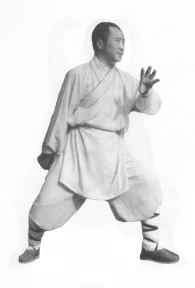 |
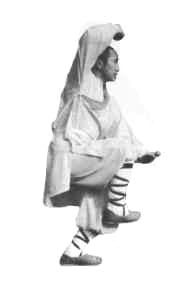 |
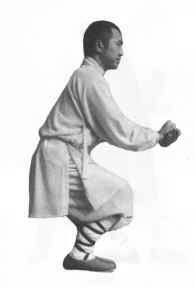 |
|
For comparison - "Buddha's Warrior Attendant Pounds Mortar" (Jin Gang Dao Dui) movement from Chen style Old Frame Taijiquan routine (performer: Chen Zhenglei): |
|||
|
|
|
||
|
Xu Zhen believed that Chenjiagou's "Long-range Boxing" had been developed from "Taizu Long-range Boxing" (Taizu Chang Quan), while Tang Hao claimed it was based on "Qi Jiguang's Boxing Canon" (which was a compilation of sixteen styles, "Taizu Long-range Boxing" being one of them). Since twenty nine postures from Qi's manual can be found in Chen's Long-range Boxing, so if all of them came from "Taizu Long-range Boxing" (as Xu Zhen suggested), then would it be possible that remaining three postures in Qi's book are from other fifteen styles? Tang Hao found it difficult to accept. Regarding "Thirteen Postures", there are five sets (actually six) recorded in Chen clan boxing manuals. "Sanxing Version" in the chapter "Thirteen Postures" (Shi San Shi) lists: "First Set" (Tou Tao), "Second Set" (Er Tao), "Third Set - its name is Big Fourth Boxing Set " (San Tao - Ci Ming Da Si Tao Chui), "Fourth Set - its name is Red Fist" (Si Tao - Ci Ming Hong Quan; the last two sentences of its boxing formula say: "If you want to know where this martial art comes from, the answer is "Taizu Xia Nan Tang"); "Cannon Boxing Postures" (Pao Chui Jiazi; below the list of names set, a ten-character long note says: "Fifteen Fists (and) Fifteen Cannons, use heart (mind) in boxing practice"). "Wenxiu Version" lists: "First Set of Boxing" (Tou Tao Chui Quanjia), "Fourth Set of Boxing" (Si Tao Chui Shi), "Fifth Set of Boxing" (Wu Tao Chui Quanshi), "Cannon Fist Postures, Fifteen Red Fifteen Cannons, use heart in practice" (Pao Chui Jiazi Shiwu Hong Shiwu Pao Zou Quan Xin Yong); besides, there is a note saying that Second Set (Er Tao Chui) and Third Set (San Tao Chui) were both lost. "Liangyi Version" contains following contents: "Boxing Song of First Set (in) Thirteen Postures" (Tou Tao Shi San Shi Quan Ge; its list of postures is almost identical with "First Set of Boxing" of "Wenxiu Version"), "Second Set Cannon Fist Fifteen Red Fifteen Cannons, practice boxing" (Er Tao Pao Chui Shiwu Hong Shiwu Pao Zou Quan); "Third Set" (San Tao), "Fourth Set, also called Red Set" (Si Tao Yi Ming Hong Tao), "Boxing Song of Fifth Set" (Wu Tao Quan Ge), "Taijiquan also called First Set or Thirteen Postures, that is Thirteen Folding (techniques) (Shi San Zhe) or Thirteen Twists (Shi San Zhe)". The list of postures of this last set (Taijiquan) is almost identical with the First Set. According to "Liangyi Version" the Second Set is called "Cannon Boxing" - "Pao Chui", but "Wenxiu Version" and "Sanxing Version" do not mention this; besides, as already mentioned above, "Wenxiu Version" has a note saying that Second Set and Third Set were both lost. If we assume that "Cannon Boxing" does not belong to five sets of Thirteen Postures, than all texts miss these two sets and none of them can be considered complete. |
"Double Rolling Hands" (Shuang Gun Shou) movements from Shaolin's Taizu Long-range Boxing (Taizu Chang Quan) (performer: Diao Huiyin): |
|
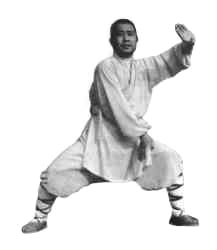 |
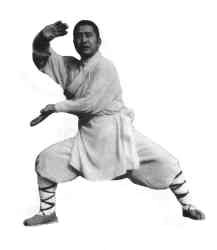 |
| For comparison - "Wave Hands" (Yun Shou) movement from Chen style Old Frame Taijiquan routine (performer: Chen Zhenglei): | |
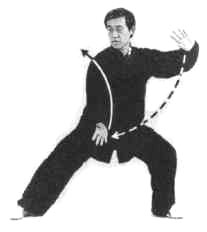 |
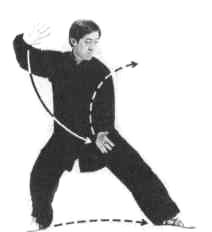 |
Weapons listed in Chen clan writings are: spear, staff, single broadsword, double broadswords, halberd (e.g. Spring and Autumn Broadsword), double straight swords, double maces, sickle, etc. SPEAR: Chen clan texts mention the following spear registers: "Four Spears" (Si Qiang), "Eight Spears" (Ba Qiang), "Thirteen Spears" (Shi San Qiang), "Twenty Four Spears" (Er Shi Si Qiang). "Four Spears" and "Eight Spears" have also matched exercises (Dui Zha Fa); "Twenty Four Spears" contain rhymed formulas (Ge Jue) and practice methods; there is Zhang Yide's[7] name affixed to "Four Spears". "Twenty Four Spears" are identical with those described in Qi Jiguang's "New Book of Effective Techniques" (Ji Xiao Xin Shu). A last sentence in "Rhymed Formulas of Twenty Four Spears" says: "If you ask what is the name of this spear, the answer is Twenty Four Flowery Spears of Yang Family". STICK: Chen Ziming's Collection contains two staff manuals (Gun Pu): "Panluo's Stick" (Panluo Bang) and "Wind Spinning Stick" (Xuanfeng Gun). "Sanxing Version" contains only "Wind Spinning Stick". The rhymed formula of Panluo's Stick says: "Shaolin Temple, ancient Buddhist monastery in Dengchu, there are five thousand monks in its halls; when a Red Army (e.g. Red Turbans rebels) of million (soldiers) wanted to destroy it, Beiluo showed its magic powers. If you want to know where this stick comes from, it was left by Panluo in Shaoling". Tang Hao explains that "Dengchu" is actually "Dengfeng", e.g. county where Shaolin Temple is situated; "Shaoling" is "Shaolin"; Panluo and Beiluo are names of boddhisatvas. Although from the text it seems that Chen clan practised Shaolin stick techniques, however Tang Hao found out that only four postures from "Panluo's Stick" and one from "Wind Spinning Stick" were identical with those from Shaolin, while other were different. BROADSWORD: Chen Ziming's Collection contains only one double broadsword manual. "Sanxing Version" contains ten matched routines of double broadswords. STRAIGHT SWORD: Chen Ziming's Collection contains only one double straight swords manual. Apart from the above contents, the manuals also contain: "General Song of Boxing Classic" (Quan Jing Zong Ge) and "Song of Pressing Hands" (Ji Shou Ge; in "Liangyi Version" it is composed of four sentences, while Chen Ziming's version has six sentences copied from other versions). |
(?-1951), seventeenth generation descendant of Chen clan, famous Taijiquan master, student of Chen Xin; in the 1920s and 30s Chen Ziming established several martials arts organizations in Huaiqing and other places in Henan Province, where he taught Taijiquan to many students. Later, through Jiang Zicheng's recommendation (Jiang's father was a governor of Huaiqing before 1911), Chen Ziming went to Shanghai to teach martial arts. Apart from teaching, Chen Ziming wrote famous "Chen Family Taijiquan Method Passed Through Generations" (Chen Shi Shichuan Taijiquan Shu) and compiled old hand-written Chen clan manuscripts into "Boxing and Weapon Collection of Chen Family Passed Through Generations" (Chen Shi Shichuan Quan Xie Huibian).The latter one was mimeographed in several copies which Chen Ziming gave to his friends, Xu Zhen being one of them. |
|
|
| Chen Ziming (?-1951) |
(1898-1967), also known as Xu Zhedong, native of Changzhou in Jiangsu Province, one of inheritors of Wu (Yuxiang) Style Taijiquan. Famous martial artist and writer, hold professor of Chinese Literature position at five universities, incl. Central University and Wuhan University. Prinicipal of Changzhou High School. Practised martial arts since the age of 14; learnt many martial arts, including Cha Quan, Elastic Kicks (Tan Tui), Taijiquan, Xingyiquan, Baguazhang, Tongbeiquan and Natural Style (Zi Ran Men) from Yu Zhensheng, Ma Jinbiao, Zhou Xiufeng, Yang Shaohou, Hao Yueru, Li Yaxuan, Du Xinwu, Tian Zuosen and others. Received true transmission of Wu (Yuxiang) style Taijiquan from Hao Yueru. In 1920-1937 established Zhengde Martial Arts Society in Changzhou. After liberation, in 1950 was a member of editorial committee for Shanghai Wushu Friendship Society; from 1950 till 1960s acted as judge in all-China martial arts competitions. Xu Zhen conducted thorough research on the history and theory of martial arts and published many books on Taijiquan, Baguazhang, Xingyiquan, Shaolin Boxing and Chang Family Boxing; |
(1897-1959), also known as Tang Fansheng, native of Wu County in Jiangsu Province, famous martial arts historian. Born in a poor family, Tang was fond of literature and martial arts since childhood. After coming to Shanghai he worked as principal of Shang'gong Primary School; in Shanghai Tang learnt Six Harmonies Boxing (Liuhequan) from Liu Zhen'nan. Later he also studied Xingyiquan and Taijiquan from Li Cunyi and Chen Fake. |
||
|
|
In 1927, suspected of being a Communist Party member, Tang was arrested but then, thanks to Zhu Guofu's help, released. The same year Tang went to Japan to study political science and law; in Japan he learnt Judo, Ken-jutsu and other arts. After returning to China Tang hold a post of editorial department director at Central Martial Arts Academy (Zhongyang Guoshu Guan); in 1930 he led a Central Martial Arts Academy representation (incl. Zhu Guofu, Yang Songshan and others) to Japan on a tour of investigation; in 1936 Tang was defending Gu Liuxin and others in court (Gu and others were suspected of being involved in "Seven Gentlemen" case). In 1941, since Tang was still active as a lawyer in spite of the Japanese invasion, he was caught by Japanese soldiers, whipped and chased away to Anhui Province. |
|
|
Tang Hao (1897-1959) |
||
|
After liberation in 1949 Tang Hao returned to Shanghai and was appointed to many posts in political and sports organizations; in 1955 Tang was appointed an advisor position with the China State Sports Committee. Tang Hao wrote many books and articles on the history of martial arts and is considered a pioneer of the history of Chinese Martial Arts and Chinese sport. Tang became especially famous for his research on the history of Taijiquan - after examining Taiji classics, Chen clan manuals, family chronicles and other text, Tang Hao draw a conclusion that Taijiquan was created/compiled by Chen Wangting of Chenjiagou Village in Henan Province. At the same time he rejected traditional view of Zhang Sanfeng as the creator of Taiji Boxing. |
||
(1528-1587), also known as Yuanjing or Nantang, outstanding strategist, Chinese national hero. Native of Penglai in Shandong Province, since childhood learnt martial arts from his father; in 1544 took his first military post, at the age of 28 took military examinations and was supposed to take part in central examinations in Beijing, but due to Mongol invasion the examinations were cancelled. After many succesful battles against Japanese pirates, Qi was nominated a chief commander and his army cleared Shandong province of pirates. From 1559 to 1561 Qi Jiguang wrote his most famous book called "New Book of Effective Techniques" (Ji Xiao Xin Shu). The book, considered a classic on strategy and martial arts, contains many chapters on both weapon and empty hand fighting. One of the most famous chapters is "Canon of Boxing" (Quan Jing), which describes a 32-Postures routine created by Qi on the basis of 16 martial arts. |
another name for Zhao Kuangyin (927-976), first emperor of Song Dynasty, traditionally considered to be the creator of Taizu Long-range Boxing. Qi Jiguang in his "New Book of Effective Techniques" mentions "Song dynasty Taizu had Long-range Boxing in Thirty Two Postures"; He Liangchen in "Records on Tactics" (Zhen Ji) includes similar note, but mentions thirty six postures instead of thirty two; Tang Shunzhi in his "Book on Martial Arts" (Wu Pian) says "Zhao Taizu Long-range boxing uses many kicks". |
(1507-1560), also known as Yingde, Yixiu or Jingchuan; renowned Mind dynasty general famous for fighting Japanese pirates; expert in martial arts, good at strategy and literary arts. In 1559 passed the central examinations as the first and was accepted to Imperial Academy (Han Lin). While holding a post of imperial inspector (Xunfu), taught and explained spear techniques to Qi Jiguang. Tang Shunzhi wrote several books of which the most famous are "Tang Jingchuan Literary Collection" (Tang Jingchuan Wenji) and "Book on Martial Arts" (Wu Pian). These works contain rich information on pre-Mind and Ming dynasty (1368-1644) martial arts, both empty hand boxing and weapons. |
(?-221), also known as Zhang Fei, historical figure from East Han (25-220) and Three Kingdoms period (220-265); Zhang was famous for his courage and spear skills; he became a sworn brother of Liu Bei and Guang Yu (famous for his halberd). Today many styles (Xingyiquan, Chang Family Boxing) contain spear routines named after Zhang "Yide Spear". |
| End of "Brief Analysis of Chen Family Boxing Manuals" by Jarek Szymanski; © J.Szymanski 2000 |
Home ▪ About me ▪ Updates ▪ Taiji ▪ Bagua ▪ Xinyi-Xingyi ▪ Other Styles ▪ News ▪ Store ▪ Community ▪ Email